Black and White Pig Breeds
The pig is a domesticated, even-toed, hoofed member of the Sus genus that is raised largely for its carcass. It has a large nose and a long, pointed head. It is also known as a hog or a swine. Pigs range in size and weight from 50 to 350 kg on average depending on breed. There are numerous types of pig breeds that are raised for their usefulness in agriculture, mothering ability, and carcass quality. Pigs’ colours might vary depending on their breed. They come in a variety of hues, including pink, white, black, grey, and brown. Their skin tone represents the level of consumer interest and meat quality. The expanding industry in livestock and animal husbandry is pig farming, also known as pork farming or hog farming. In the United States today, there are more than 60,000 pig farms. They raise pork to satisfy a wide range of consumer demands, and they come in different sizes and types of farms.
Here is our list of Black and white pig breeds:-
1. Large White Yorkshire
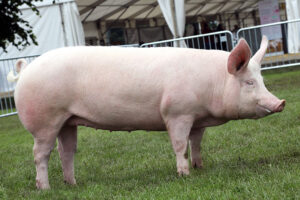
Large white pig are of the English white swine breed. Their bodies are long and deep-sided, and their narrow, long, and upright ears. Their chest is deep and wide, and their neck is long and thick to the shoulders. They have a dished face and straight, evenly spaced legs. Their skull nearly completely flattens out to where their eyes are, and from there it curves over to their snout. Their adult sow weighs between 250 and 350 kg, and the mature boar is between 300 and 400 kg. Their backs are long, flat, and wide. They are actually referred to as the mother breeds since they are a maternal breed. They are a well-liked breed with good mothering and milking capacities. They do have high-quality carcasses.
2. Berkshire

They are Berkshire County, England-native black swine varieties with white legs. They were actually the first registered boars, produced by Queen Victoria, and the first breed whose herd book had pedigrees. Their short, upturned snout, upright ears with the suffix “shire” at the end, black body coat with rising white patterns, white legs, and a propensity for white spots on their face and tail help to identify them. A purebred Berkshire can’t be registered if more than 10% of its body colour is white. They are the optimum meat type hog because they are a terminal breed. They are valued for their juiciness, flavor, and softness, and have extremely high quality carcasses. They frequently contain meat that is very fat filled and extremely marbled. This meat is extremely sought-after, particularly in Japan where it is sold as “black pork.”
3. Chester White

The Pennsylvania county of Chester, where the Chester white was initially bred, bears its name. They have ancestry with the Yorkshires. They have small, drooping ears without the shire suffix and a fairly enormous size. They may have freckles or blue markings on their body. To qualify as Chester whites, a person must be at least 95% white. They are noted for their exceptional mothering skills because they are a maternal breed. Additionally, they have a very high rate of conception. They are 12% more likely than other breeds to have successful pregnancies and are simple to give birth to. They frequently have larger litters and a high survival rate of piglets. They make excellent breeding stock and they tend to have larger litters and a high survival rate of piglets. They are excellent breeding stock and develop quite quickly for the market.
4. Hampshire
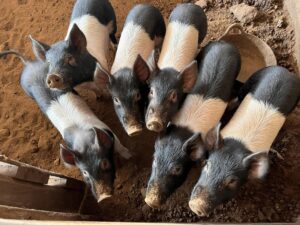
Because of the white stripe or belt running down the middle of their black bodies, these breeds are simple to identify. One of the more miniature breeds. Therefore, it won’t be as significant as others. Their faces are often long and straight. They have great lean flesh and develop really quickly. These guys frequently perform admirably in confined settings. This breed is also terminal. So, a market hog with exceptional muscling. It is the market leader for premium carcasses. As a result, it is frequently utilised in cross breeding to improve other breeds’ muscling and carcass quality.
5. American Landrace

Img Source: American Landrace
It is a local Danish landrace breed that is descended from the Danish breed. US landraces have a reputation for being an extremely maternal breed. They produce more milk and bigger piglets, and they are great mothers. In contrast to most pigs, they have unusually flat backs, lengthy bodies, deep sides, and white hair on pinkish-white skin. They are frequently difficult to distinguish from Chester White because of their straight snouts and big, floppy ears. They have a meaty carcass, are medium in size, and have a very high feed efficiency. Because they are utilised so frequently in cross breeding to improve the mothering qualities of other breedstock, they are known as America’s sow herd.
6. Poland China
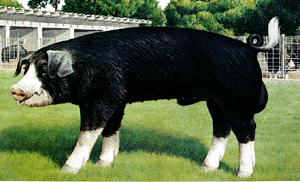
This breed, a terminal type recognized for having good length in the body, thick ham regions, and an attractive carcass, was established in the Ohio River Valley in the 1800s. It resembles Berkshire a lot. It has a black body with some white on the legs, face, and tail. To set them apart from the Berkshires, they have floppy ears. Because of their high cell lifespan and excellent adaptability to various living conditions, they can be bred for longer periods of time than conventional pigs.
7. Spotted
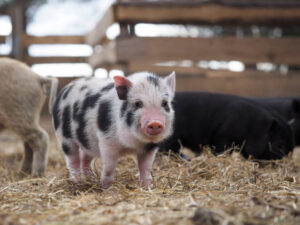
Actually, the spotted breed shares the same genetics as the Poland China breed. The colour of its coat is the only distinction. Initially, these were known as spotted polands. They are a terminal breed that was also developed in Ohio. However, they do have the spotted sections that tend to have a kind of greyish area around the black dots. Ideally, they are approximately 50% black and 50% white. These resilient pigs have a very high rate of conception. Spotted swine are quite difficult to distinguish from petrains. The most important difference is that they have longer, slimmer torso and legs than Pietrains.
8. Black Iberian
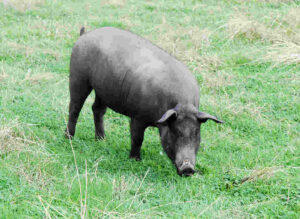
The herds of this domestic pig breed can be found in the central and southern regions of Portugal and Spain. It is a native of the Iberian Peninsula. Neolithic times are when the Iberian pigs first appeared. The Iberian pigs that exist today are descended from the black pigs that the Phoenicians introduced to the Iberian Peninsula and interbred with wild boars. They are one of the few domesticated pigs that have adapted to living in pastoral areas with abundant natural resources. They have long snouts, long floppy ears that cover their eyes, and long legs. They have dark hooves and are coated in thick hair. Their sows produce healthy litters of 8 to 10 piglets on average. Both the sow and the boar weigh over 420 pounds on average. They are highly susceptible to obesity. Iberian hams are dried-cured for at least 36 months before being hanged.
9. Aksai Black Pied
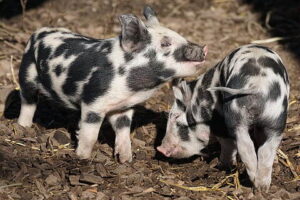
The Kasalenki state breeding and the Aksai experimental and training farms in Kazakhstan produced the distinctly black and white spotted Aksai Black Pied pig breed as a meat producing pig. It has a bulky physique, long, upright ears, and robust, powerful legs. They have a creamy to white body coat with erratic spots of black or grey. They have curled tails and large muzzles. Boars typically weigh 317 kg, whereas sows weigh 245 kg. They have a lifespan of roughly 15 to 18 years and can bear litters of 9 to 10 piglets. In general, these animals are raised for meat. They can also be utilised in agriculture, though.
10. Bentheim Black Pied
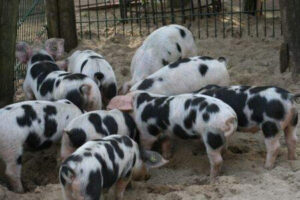
A uncommon breed of domestic pig that originated in Bentim, Germany, the Bentheim Black Pied is also known as Schwarz-Wesses or Buntes Bentheimer Schwein. It was created by mating regional breeds with Cornwall and Berkshire cattle. In the 1950s, it was on the verge of extinction, and barely 100 herds remain now. They have a modest stature, lop-eared appearance, and a white coat with black patches. Boars can grow to a height of 75 cm and weigh 250 kg on average, while sows can grow to a height of 70 cm and weigh 180 kg on average. They have a high fertility rate, are resilient, and live long lives.
11. Angeln Saddleback
Developed in Germany by mating the Wessex Saddleback pig with the black and white landrace pig, the Angeln Saddleback is a rare breed of domestic black and white pig. They are large-sized pigs whose meat was in demand. They are currently only grown in the German state of Angeln and in a very small area. Their market shrank when consumers complained that it was excessively fat.
12. Ba Xuyen
Domestic pigs of the Ba Xuyen breed originated in South Vietnam, most specifically in the Mekong Delta. It is a spotted, black and white pig with white feet that was created by crossing a Boxu and a Berkshire. It is a short-bodied, medium-sized pig that weighs 100 kg on average. They have patches of black skin that range in colour from white to reddish. Their enamel-coated teeth resemble those of humans. Per litter, they have about 8 piglets. They have evolved to live in the Mekong river’s salty water regions. They are raised mostly for their premium meat.
Conclusion
Different black and white pig breeds are raised based on the climate and their place of origin. Yorkshire pigs are the most prevalent breed bred commercially. Breeds like Hampshire and Berkshire are chosen for their excellent development and carcass characteristics, which result in more meat per finished pig. Pig breeds are chosen by farmers based on consumer demand and market conditions.
